Revelation: Chapter 7
Setting
This chapter is parenthetic to insert additional and amplifying information without advancing the timeline on its march toward Armageddon. What is introduced is the:
- Role of angelic beings in executing God’s judgments
- Hierarchy of the angelic domain
- Identification of the 144,000 believing Israelis
- The Gentile multitudes martyred for the name of Jesus Christ
This chapter also serves as the introduction to the beginning of God’s judgments. Isaiah wrote how God’s judgments are received by the righteous and the wicked in Judah, which is appropriate for the world as it enters the time of God’s judgments in the tribulation. He begins by showing the heart of the righteous, Isaiah 26:8-10, where:
- In the way of God’s judgments, they have waited for Him
- The desire of their soul is to God’s name and the remembrance of Him
- With their soul they have desired God in the night
- They seek God early in the morning
Isaiah ends this part concerning the righteous, saying that when God’s judgments are on the Earth, the world's inhabitants will learn righteousness.
Isaiah describes the wicked's response to God’s judgments, Isaiah 26:10-11, where:
- Let God’s blessings be shown to the wicked, and they will not learn righteousness
- In the land of the righteous, the wicked will deal unjustly
- The wicked will not see God nor observe His ways
- When the Lord’s hand is lifted up, they see or understand, but:
- They will see the judgment against them and be ashamed for their envy of the righteous
- The fire of God’s enemies will consume them
As seen in the chronology of Revelation, John is viewing these events of this chapter from the perspective of earth with the resultant activity of the slain saints in heaven.
| Verses | Topic |
|---|---|
| 1-3a | Judgment being held for a moment |
| 3b-8 | Sealing 144,000 out of the 12 tribes of Israel |
| 9-12 | The innumerable multitude before the throne |
| 13-17 | Identity of the great multitude |
This is the beginning of many passages in Revelation where the angels have a direct role in the judgments against the enemies of the Lord. Angels appeared many times with major roles in the visions of Daniel, Daniel 7-12. An example is in Daniel 7:2-3, where the four winds stirred up the great sea, and out came the four beasts. There were associations of angels with national events on earth in Daniel 10:1-21.
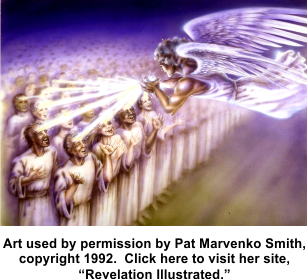 In Revelation 7:3-4, before the commencement of God's judgments upon His enemies in this world, the remnant of Israel who serve God were to be sealed. This is one of many examples in the Bible where the Lord separates His own from those who will suffer His judgment, Ezekiel 9:27, Luke 21:36. This pause before breaking the seventh seal is for an angel to identify and mark those specific believing Israelis for His service during the seven years of tribulation. Scripture does not say where these Israelites come from, but just as Paul the apostle was called by the Holy Spirit out of the church at Antioch for God’s service, so the 144,000 are likely members of the tribulation churches, Revelation 2-3, Acts 13:1-4. Two groups of saints are identified in this chapter. The first group consists of 144,000 Israelites from the twelve tribes of Israel, who will live through the seven years of tribulation, and the second group consists of saints who were slain during the great tribulation, the second half of the tribulation. All this occurs following the opening of the sixth seal and before the opening of the seventh seal, which brings in the judgments of God.
In Revelation 7:3-4, before the commencement of God's judgments upon His enemies in this world, the remnant of Israel who serve God were to be sealed. This is one of many examples in the Bible where the Lord separates His own from those who will suffer His judgment, Ezekiel 9:27, Luke 21:36. This pause before breaking the seventh seal is for an angel to identify and mark those specific believing Israelis for His service during the seven years of tribulation. Scripture does not say where these Israelites come from, but just as Paul the apostle was called by the Holy Spirit out of the church at Antioch for God’s service, so the 144,000 are likely members of the tribulation churches, Revelation 2-3, Acts 13:1-4. Two groups of saints are identified in this chapter. The first group consists of 144,000 Israelites from the twelve tribes of Israel, who will live through the seven years of tribulation, and the second group consists of saints who were slain during the great tribulation, the second half of the tribulation. All this occurs following the opening of the sixth seal and before the opening of the seventh seal, which brings in the judgments of God.
Interestingly, the seal of the living God upon the 144,000 will be on their foreheads. This is unlike the Body-of-Christ today, where:
- We are sealed by the Holy Spirit the moment we believe in the Lord Jesus Christ for our salvation, Ephesians 1:13
- This is God’s seal of ownership on us, 2Corinthians 1:22
- We are all immediately baptized into the Body-of-Christ, 1Cor 12:13
- We remained sealed until the day of redemption, Ephesians 4:30
This new event occurs when God’s prophetic plan for Israel is fully engaged, since the church has already been snatched away (raptured). As in Ezekiel’s day, the Lord’s mark on the 144,000 Israelites will protect them from God’s wrath, Revelation 9:1-4. Lot had a similar experience when the angels could not bring judgment on the plain of Sodom and Gomorrah until Lot left for Zoar, Gen 19:22. The Lord is delivering believers of Israel from the tribulation, Dan 12:1, Isaiah 26:20. As the Lord sent out the 12 apostles to Israel, He will send the 144,000, but these will go throughout the world, evangelizing everyone to believe on Christ Jesus, Matthew 10:5-42. When persecuted in one city, they flee to another, Mat 10:23. The following graphic illustrates the four groups of Israeli believers going through the tribulation (a fifth will be the two witnesses, not shown on the graphic, Revelation 11:3-12). There are relevant passages for each group on what they are to do during the tribulation, and at the bottom of the graphic is an illustration of who is the significant source of persecution of believers in Christ Jesus, and when during the seven years of tribulation.
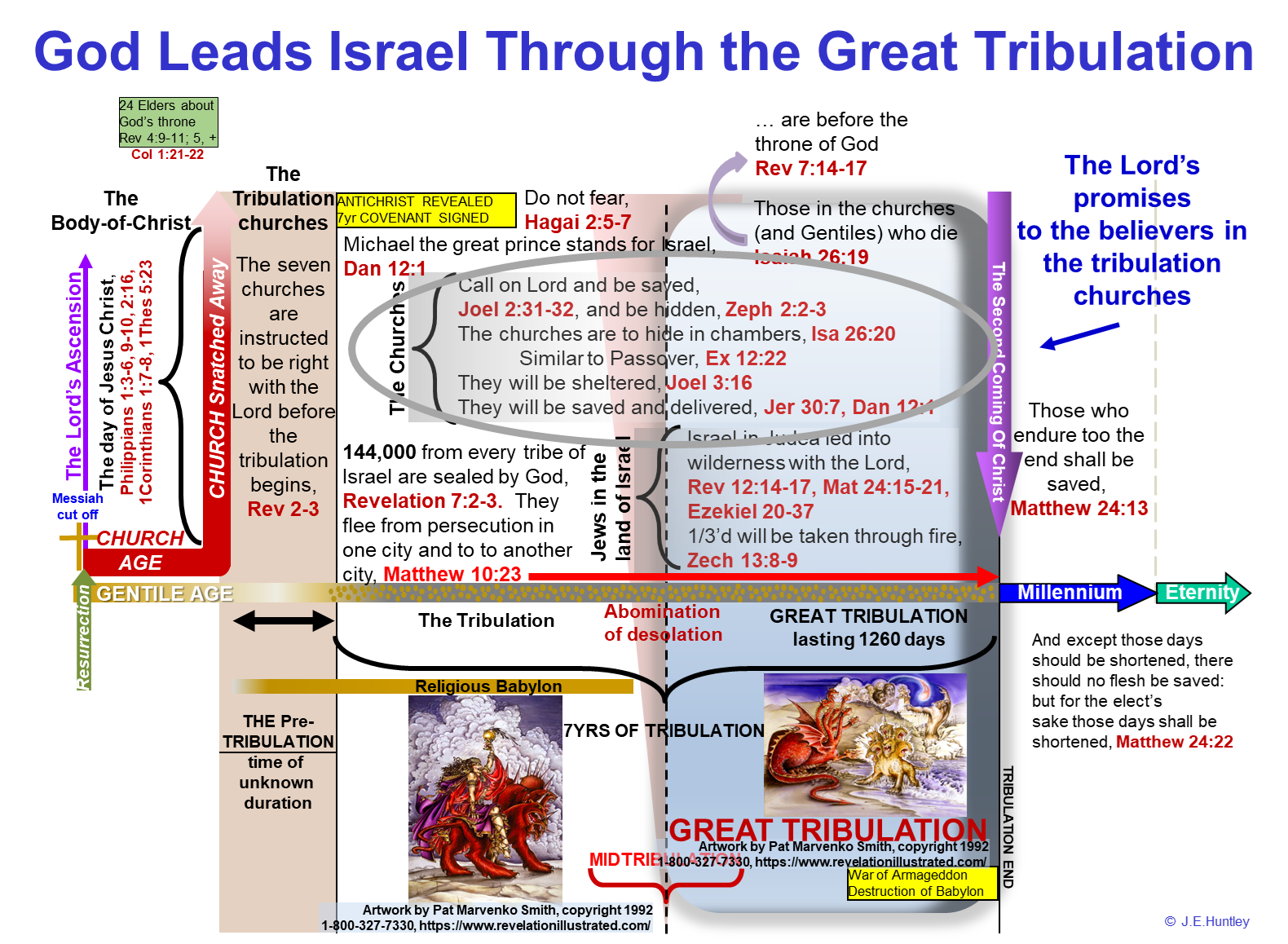
A similar occurrence segregating the faithful from the unrighteous was during the third conquest of King Nebuchadnezzar against Judah, when God was preparing to judge Jerusalem, as recorded in Ezekiel 9:3-11. Before the final battle against Jerusalem, an angel was sent to mark the foreheads of those who grieved about the detestable things done in the temple of God. This was done just before the glory of the Lord departed completely from the temple. God's judgment began at the temple and then outward. None were spared because of either age or sex from death. All who were not sealed died, but only those who were sealed lived.
As in Ezekiel's day, an angel at the beginning of the seven years of tribulation was to go out and mark the foreheads of God's servants. The purpose of the sealing was twofold:
- It identified them as belonging to God
- They were separated from the coming judgments of God against the world
This is also similar to the experience of Israel when God was plaguing Egypt. From the fourth plague on, the land of Goshen (Israel) did not suffer from the plagues, Exodus 8:21-23.
 It is not stated here at all that the tribulation saints are also sealed with the mark of God once they believe in the Lord Jesus Christ, only the 144,000. Similarly, in the days of the apostles in the early Jerusalem church, Luke recorded how, through the apostles, many signs and wonders were done among the people, and all the believers in Christ Jesus were in one accord. However, they had faced persecution and would face greater persecution soon afterward, Acts 5:12-13. Likewise, the 144,000 will be separated from the rest of the believers to deliver God’s faithful Word to a faithless world and to encourage the faithful as they all stand in one accord in Christ Jesus, as the rapidly growing threat of persecution remains before them. In all cases, the Lord knows those who are His, 2Timothy 2:16-19, and to them he gives eternal life, and no one can snatch them out of His hand or the Father's hand, John 10:25-30.
It is not stated here at all that the tribulation saints are also sealed with the mark of God once they believe in the Lord Jesus Christ, only the 144,000. Similarly, in the days of the apostles in the early Jerusalem church, Luke recorded how, through the apostles, many signs and wonders were done among the people, and all the believers in Christ Jesus were in one accord. However, they had faced persecution and would face greater persecution soon afterward, Acts 5:12-13. Likewise, the 144,000 will be separated from the rest of the believers to deliver God’s faithful Word to a faithless world and to encourage the faithful as they all stand in one accord in Christ Jesus, as the rapidly growing threat of persecution remains before them. In all cases, the Lord knows those who are His, 2Timothy 2:16-19, and to them he gives eternal life, and no one can snatch them out of His hand or the Father's hand, John 10:25-30.
This was even demonstrated in the Old Testament by God during Korah's rebellion during Israel's exodus, against the law of God, Numbers 16:1-7, 20-24, 31-35. During this rebellion, Korah and his followers were on one side of the camp, and Moses and those who followed him were on the other. God's judgment was sudden and complete upon all those who rebelled against the authority of Moses, which was endowed upon him by the Lord.
After the snatching away (rapture) of the church, the Holy Spirit will not hinder the Antichrist from assuming his full power from Satan, 2Thessalonians 2:8-9, for many antichrists have been at work since the beginning of the church, 2Thessalonians 2:7, 1John 2:18-22. However, the Holy Spirit will continue His work calling out those from the world unto life in Christ as tribulation saints. The snatching away (rapture) of the church will end the age of grace. The time of judgment will follow after the church's rapture until the battle of Armageddon, Revelation 19:12-21. Afterwards, the kingdom age will commence with the Lord Jesus Christ having the world's governments upon His shoulders, Isaiah 9:6-7.
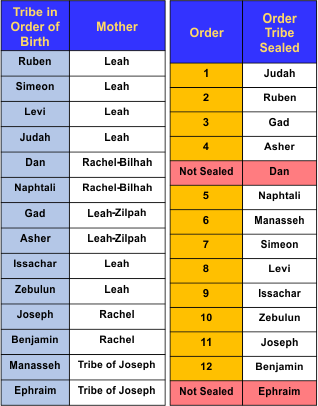 There is a second reference to another 144,000 in Revelation 14:1-3. These are not the same individuals. Those identified in Revelation 7:4-8 survive the tribulation, and the Gentile survivors will be judged after the battle of Armageddon on how they treated the 144,000, Matthew 25:31-46. The second 144,000 are slain at the beginning of the great tribulation, and they are before the throne of God, Revelation 14:11-3.
There is a second reference to another 144,000 in Revelation 14:1-3. These are not the same individuals. Those identified in Revelation 7:4-8 survive the tribulation, and the Gentile survivors will be judged after the battle of Armageddon on how they treated the 144,000, Matthew 25:31-46. The second 144,000 are slain at the beginning of the great tribulation, and they are before the throne of God, Revelation 14:11-3.
The twelve tribes of Israel are identified in Revelation 7:5-8, where 12,000 in each tribe were sealed: Judah, Reuben, Gad, Asher, Naphtali, Manasseh, Simeon, Levi, Issachar, Zebulun, Joseph, and Benjamin. The list of tribes, by birth order and showing their birth mother, is given in the following table. The second adjacent table shows those tribes who are part of the 144,000, but are listed in order of who has been sealed.
In Revelation 7:5-8, there is a listing of all the tribes from whom the 12,000 would be sealed. Variations in the listing of the tribes of Israel have been observed in other passages in scripture, but this listing may have some significance. Judah is listed first, though Reuben was the firstborn. This is probably a result of the action by Reuben, who lost his birthright due to his incestuous relations with his father's concubine Bilhah, Rachel's servant, 1Chronicles 5:1. His birthright was given to Joseph. However, in the psalm by Asaph, the Lord revealed that the Lord rejected Joseph to have prominence over Israel, and He rejected Joseph's firstborn, Ephraim. Instead, the Lord chose Judah as the lead tribe, Psalm 78:67-72. Judah is listed first because this was the line through which the Messiah, Jesus Christ, would come, Genesis 49:8-12. The tribes of Dan and Ephraim are not counted in the 144,000, and in their stead, Joseph and Levi are counted.
Though no details are given on why Dan and Ephraim are not part of the 12 tribes being listed, it may be inferred from scripture that they are being judged because they led in Israel's apostasy. Nevertheless, all tribes are represented during the millennial kingdom. The Lord had warned Israel concerning the nations that they were going to destroy in the land of Canaan, and about the idols these nations worshiped. If they fell into the same sin, they would be separated from the tribes of Israel, Deuteronomy 29:18-21.
Early in Israel's history in the promised land, the tribe of Dan was the first to establish idol worship in Israel. In the hill country of Ephraim, Micah (not the prophet), made a graven image of silver and put it in his own house of gods. A Levite journeyed from Judah to the land of Ephraim. When the two men met, Micah hired the Levite as his priest, Judges 17:1-13. Soon afterwards, the tribe of Dan needed more land, and they sent an army northward to conquer new land. As they passed Micah’s house, the Danites stopped to take his idols and the Levite. When they conquered land for their tribe’s expansion, they settled in it and renamed it “Dan.” Then, they set up the graven image and had the Levite, who was in the line of Moses, serve as priest of the idols. He and his sons continued as priests to the idols until the day the northern tribes were taken into captivity, Judges 18:1-31. This situation remained in place all the time the tabernacle of God was in Shiloh.
Later in Israel's history, the kingdom became divided into the northern and southern kingdoms. In 1Kings 12:26-32 are recorded the events that led the northern kingdom into idolatry. In fear of losing his power as king over the northern tribes of Israel, King Jeroboam, who was of the tribe of Ephraim, 1Kings 11:26, 31-33, established two areas of golden calf worship so his people would not need to worship in Jerusalem. One location was in Dan and the other in Bethel. In Hosea 4:17-19, God declared that Ephraim is joined to idols. Again, despite Dan and Ephraim not being part of the 144,000 in the tribulation, all tribes are represented during the millennial kingdom, Ezekiel 48:2, 6.
The Lord warned Israel, that if any man, woman, family or tribe followed the abominations of the nations they removed from the land they entered into, God’s anger would be against them, all the curses written in His book would be against them, and the Lord shall blot out their name from under heaven. The Lord would also separate them unto evil out of all the tribes, Deuteronomy 29:16-21. Additionally, in the middle of the tribulation period, after the Antichrist reaches the heights of his Satanic power that he will achieve in this world, the Lord sends three angels to warn all mankind of the judgments to come. The first flies around the world announcing the everlasting gospel, preaching to every nation, tribe, tongue, and people, Revelation 14:6-7. A second angel is sent to announce the fall of Babylon, because she has made all nations drink of the wine of the wrath of her fornication, Revelation 14:8. A third angel was sent to warn all peoples that anyone who worships the beast and his image, or receives his mark on his forehead or his hand, that person will drink of the wine of the wrath of God, which is poured out in its full strength. He will also be tormented with fire and brimstone in the presence of the holy angels and the presence of the Lamb, Revelation 14:9-12.
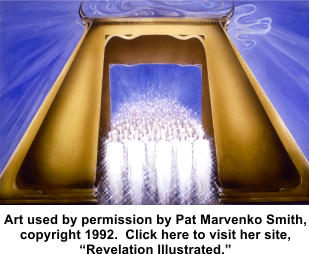 In Revelation 7:9, John observes a great multitude, which no man could number, from all over the world. They stood before the throne, and before the Lamb, clothed with white robes, and palms in their hands. In Revelation 7:10-12, there is great praise, singing, and worship of God who sits on the throne and of the Lamb. Then the angels, elders, and four creatures fell and joined in the worship of God and the Lamb.
In Revelation 7:9, John observes a great multitude, which no man could number, from all over the world. They stood before the throne, and before the Lamb, clothed with white robes, and palms in their hands. In Revelation 7:10-12, there is great praise, singing, and worship of God who sits on the throne and of the Lamb. Then the angels, elders, and four creatures fell and joined in the worship of God and the Lamb.
In Revelation 6:1-17, with the opening of the first six seals, there is no indication given of the time between the openings of each seal. As with other chapters of Revelation, one is expected to be opened immediately after the other. The innumerable multitudes are great tribulation saints, converted after the rapture through the missionary work of the 144,000. This is the greatest revival in world history.
The tribes of Israel were never numbered with the nations. God ordained that Israel would not be reckoned with the nations, Numbers 23:9. But, in the millennium, the nations' inheritance depends upon the number of Israelites, Deuteronomy 32:8. The great worldwide witness of the 144,000 is similar to the experience of the Jewish church, the “little flock,” Luke 12:32, on the day of Pentecost. In Acts 2:1-4, the church grew immediately from that one room in Jerusalem as the Holy Spirit empowered the apostles. The 144,000 Jews are sealed and empowered to spread the gospel worldwide and are prolific in spreading the word of God.
In Revelation 6:9-11, the Lord opened the fifth seal. This is when John saw the souls of the tribulation saints under the altar. It was revealed why they were slain and the witness they kept.
- They were slain because of the Word of God
- They were also slain for the testimony they maintained
- Revelation 6:10 - They cry out to God to avenge their blood (the "inhabitants of the earth" equates to those who reject Christ)
- In Revelation 6:11 - Each person was given a white robe
- They were told to wait a little longer until the number of their brethren to be killed has been reached, which will occur at the battle of Armageddon
This innumerable multitude represents another group of saints slain during the last half of the tribulation, or the "great tribulation". The Lord told those revealed in the fifth seal to wait for these numbers of saints. A summary chart on these different groups of saints is three groups of tribulation saints elsewhere on this site.
John describes this vast group of people as:
- No one could count them
- They were from every nation, tribe, people, and language
- They stood before the throne and in front of the Lamb
- They were wearing white robes
- They were holding palm branches
- They sang a song giving glory to God and the Lamb, and the angels who surrounded the elders, four creatures, and the innumerable multitude joined in the chorus
This innumerable multitude are saints who believed after the sealing of the 144,000, and with the onset of the trumpet judgments. They will go through the great tribulation Jesus warned about, Matthew 24:21. This is the greatest revival in world history. Many are slain for the Word of God and their testimony, Revelation 1:9, Revelation 6:9. This event is similar to the experience of the Jewish church, the “little flock,” Luke 12:32, on the day of Pentecost. That was when the power of the Holy Spirit fell on the apostles and other disciples (Jews), Acts 2:1-4. The church grew immediately from that one room in Jerusalem. The 144,000 Jews are sealed with the seal of the living God, Revelation 7:2, and empowered to spread the gospel worldwide.
As an important aside, the palm branches were associated with the ingathering celebration or the Feast of Tabernacles (on the 15th day of the 7th month for seven days), Leviticus 23:40. Also, Leviticus 23:33-44, Zechariah 14:16-21, John 12:12-15 are prominently used by the innumerable multitude before the throne, (other verses on the feast of ingathering - Exodus 23:16, Exodus 34:22, Nehemiah 8:14-16).
The palm tree was associated with the temple worship. King Solomon decorated the walls of the inner court and outer court by carving into the walls the figures of the cherubim, palm trees, and open flowers, 1Kings 6:29. The Lord will also decorate the wall of His millennial temple with carvings of palm trees alternating with cherubim, Ezekiel 41:17-20.
The palm tree and its fruit were used in the Song of Solomon to describe the passion, great love, and desire that the king had for the woman who was his love and spouse, Song of Solomon 7:6-9, with the bride breaking in from Song of Solomon 7:9-10. It is not difficult to transpose this episode on King Solomon's life onto the expected relationship the Lord will have for His own, the love, care, and desire for them. A manifestation of His love could be decorating His walls in His millennial temple with representations of His love for them. The temple worship was about the love relationship between God and His people. It looked forward to that great event of Jesus Christ dying on the cross, being buried for three days, then rising from the dead according to scripture, 1Corinthians 15:1-4. That singular event forever settled the sin question would be covered for those who believe in His name, and confess His name, Hebrews 9:23-28.
In Revelation 7:10-12, the great multitude praises God, Salvation belongs to our God, who sits on the throne, and to the Lamb.
There are seven points in the praise of God by the entire heavenly host, the angelic host, the elders, and four living creatures, about the throne in response to the great multitude's praise:
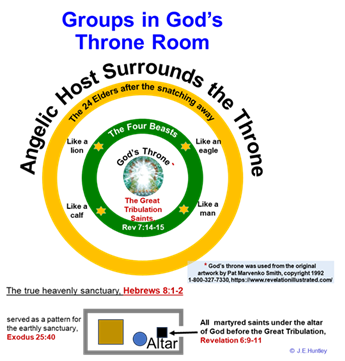 The circular graphic adds to what was shown in Revelation 6 concerning the locations of the heavenly entities about the throne of God. Now, the great tribulation saints are seen directly in front of the throne of God.
The circular graphic adds to what was shown in Revelation 6 concerning the locations of the heavenly entities about the throne of God. Now, the great tribulation saints are seen directly in front of the throne of God.
All these before God’s throne fell on their faces and worshipped God. Then they said Amen: Blessing, and glory, and wisdom, and thanksgiving, and honor, and power, and might, be unto our God for ever and ever. Amen.
This is heard at the beginning of the tribulation and throughout the entire seven-year period. God is sovereign over all His creation, including man and this world. One can only imagine the shouts of joy and unbridled excitement by the tribulation saints in response to seeing the glory of the Lord, His majesty, and the fulfillment of all the promises made to them.
In Revelation 7:13, an elder asks John to identify who this group was and where they came from. John was not asked to identify the elders in Revelation 4:1-11 and Revelation 5:1-14, since it is inferred that he was familiar with them or was made aware of their association with the events in the revelation being given him. An example is when he, with just a few other disciples of Jesus Christ, went with Him on the Mount of Transfiguration, where they recognized the two Old Testament saints, Moses and Elijah, Luke 9:28-33. When they appeared with Jesus on the mount, though they never met them physically, the disciples knew them as they were well aware of their teachings and prophecies. However, John does not recognize the source of this great multitude, as there was no context for him to know, since all of these people are far into the future relative to John's day and are identified in the age of judgment, not the age of grace that John was part of.
In Revelation 7:14-17, the elder reveals to John the identity of the great multitude, attributing to them many characteristics:
- They came out of the great tribulation
- They have washed robes made white by the blood of the Lamb
- They are before the throne of God and serve him day and night in his temple
- They will never hunger or thirst
- They will not suffer heat, a characteristic of the seven years of tribulation (not the global warming scenario being preached by some today, but a Godly heating)
- The Lamb will be their shepherd to care for them. God will wipe away every tear from their eyes
This group of great tribulation saints will be seen again in the remaining chapters of Revelation.
